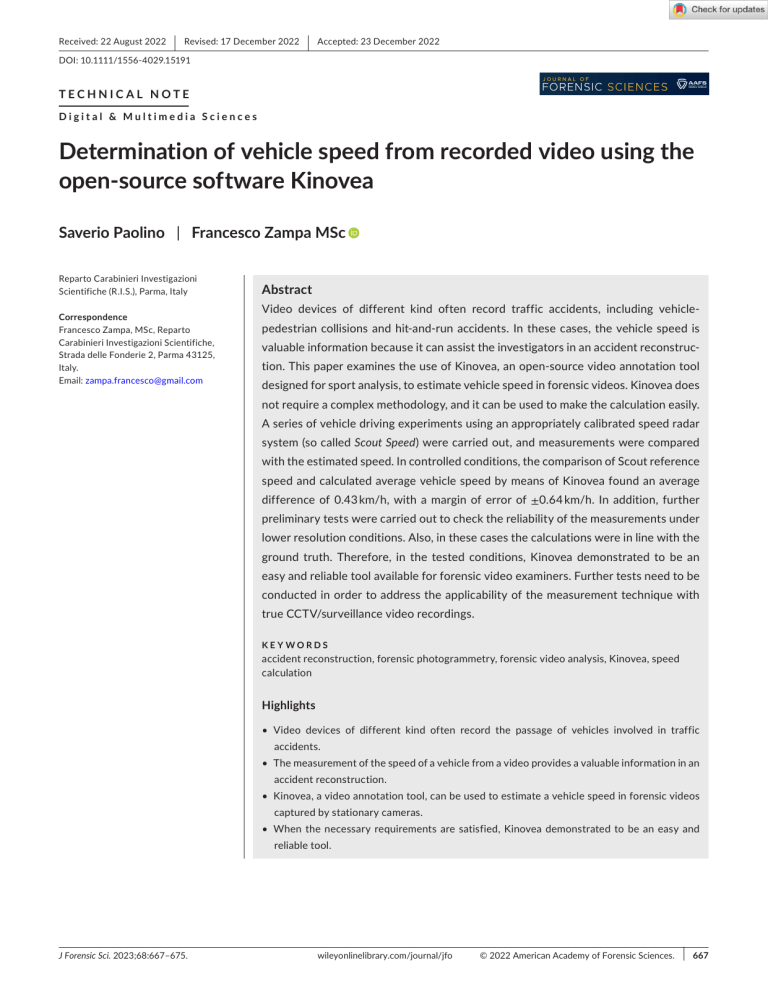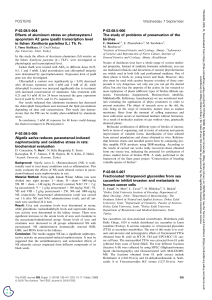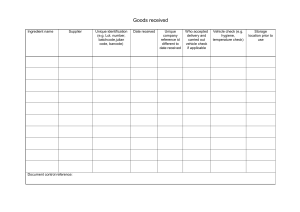Journal of Forensic Sciences - 2022 - Paolino - Determination of vehicle speed from recorded video using the open‐source
advertisement

Received: 22 August 2022 | Revised: 17 December 2022 | Accepted: 23 December 2022 DOI: 10.1111/1556-4029.15191 TECHNICAL NOTE Digital & Multimedia Sciences Determination of vehicle speed from recorded video using the open-­source software Kinovea Saverio Paolino | Francesco Zampa MSc Reparto Carabinieri Investigazioni Scientifiche (R.I.S.), Parma, Italy Correspondence Francesco Zampa, MSc, Reparto Carabinieri Investigazioni Scientifiche, Strada delle Fonderie 2, Parma 43125, Italy. Email: zampa.francesco@gmail.com Abstract Video devices of different kind often record traffic accidents, including vehicle-­ pedestrian collisions and hit-­and-­run accidents. In these cases, the vehicle speed is valuable information because it can assist the investigators in an accident reconstruction. This paper examines the use of Kinovea, an open-­source video annotation tool designed for sport analysis, to estimate vehicle speed in forensic videos. Kinovea does not require a complex methodology, and it can be used to make the calculation easily. A series of vehicle driving experiments using an appropriately calibrated speed radar system (so called Scout Speed) were carried out, and measurements were compared with the estimated speed. In controlled conditions, the comparison of Scout reference speed and calculated average vehicle speed by means of Kinovea found an average difference of 0.43 km/h, with a margin of error of ±0.64 km/h. In addition, further preliminary tests were carried out to check the reliability of the measurements under lower resolution conditions. Also, in these cases the calculations were in line with the ground truth. Therefore, in the tested conditions, Kinovea demonstrated to be an easy and reliable tool available for forensic video examiners. Further tests need to be conducted in order to address the applicability of the measurement technique with true CCTV/surveillance video recordings. KEYWORDS accident reconstruction, forensic photogrammetry, forensic video analysis, Kinovea, speed calculation Highlights • Video devices of different kind often record the passage of vehicles involved in traffic accidents. • The measurement of the speed of a vehicle from a video provides a valuable information in an accident reconstruction. • Kinovea, a video annotation tool, can be used to estimate a vehicle speed in forensic videos captured by stationary cameras. • When the necessary requirements are satisfied, Kinovea demonstrated to be an easy and reliable tool. J Forensic Sci. 2023;68:667–675. wileyonlinelibrary.com/journal/jfo © 2022 American Academy of Forensic Sciences. | 667 | 1 | PAOLINO and ZAMPA I NTRO D U C TI O N under controlled conditions, further preliminary tests were carried out to check the reliability of the measurements under lower reso- Video devices of different kind often record traffic accidents, includ- lution conditions. ing vehicle–­pedestrian collisions and hit-­and-­run accidents. In these cases, the vehicle speed is a valuable information because it can assist the investigators in an accident reconstruction, especially when there is insufficient evidence at the scene (e.g., skid marks) [1, 2]. An early work was reported by Compton et al. [3] that calcu- 2 | M ATE R I A L S A N D M E TH O DS 2.1 | Driving test and setup of cameras lated the vehicle speed by a simple distance–­time calculation. The location of the vehicle was, however, made either through obser- The driving test was performed on a freeway closed to traffic for vation by independent assessors or through comparison with some the duration of the experiment. A sufficiently long and straight reference points. Different methods have been proposed over the stretch of the road was chosen. As shown in Figure 1, a rectangle years to obtain the vehicle speed from a stationary camera [4–­6]. of (4 m × 7 m) was marked on the road using four white cardboards Independently of the specific method, photogrammetry [7] is gener- sheets (A4 format) secured by bi-­adhesive tape. ally used to estimate the distance while the knowledge of the timing Three stationary cameras (JVC GS-­TD1BE, CANON XF405, and of the recording systems is used to get the time difference. Based JVC GY-­HM750E) were installed on tripods, one perpendicular to on this, the average speed of the vehicle between two frames can the straight road and the others with (opposite) angle views of about be calculated. 30° with respect to the road. (Figure 2). Kinovea is a video annotation tool designed for sport analysis [8]. It features utilities to capture, slow down, compare, annotate, and Multiple angle views were used in order to verify a possible influence on the measurements. measure motion in videos. Kinovea is completely free and open The frame rate of the obtained videos was 29.97 frames per sec- source. The video player is based on the FFmpeg libraries and thus ond (fps) for the JVC GS-­TD1BE camera and 25 fps for the other two. can decode video encoded to a supported format specification. It The evaluation of frame rate in recorded videos was performed ex- should be noted that FFmpeg may not properly decode proprietary ploiting the Amped FIVE [9] file info-­frame analysis tool. The ffprobe video file formats often found in CCTV video files. The user inter- reports generated by the Amped FIVE tool are shown in Table A1 in face is also available in 26 languages. Appendix 1 for each camera. In addition, a cell phone stopwatch dis- This article proposes the use of Kinovea to estimate a vehicle playing hours, minutes, second, and fractions was used as external speed in forensic videos captured by stationary cameras. Kinovea timing source through recording a test video for each camera. These does not require a complex methodology and it can be used to make analyses allowed to verify that the frame rate of each camera was the calculation easily. Vehicle driving experiments were carried out constant all over the recorded videos [10]. It is important to perform using an appropriately calibrated speed radar system (Scout Speed) this analysis before using Kinovea. Indeed, being that the software and comparing its measurements with the estimated speed in order uses the FFmpeg libraries, it will default to a constant frame rate to assess the usefulness of Kinovea in real traffic accident cases. The when it cannot decode wrapper timing information. first objective of these tests was to verify if the calculations made by All the cameras had a full-­HD resolution of 1920 × 1080 pixels means of Kinovea were reliable. Therefore, the selection of the cam- and were setup to deliver video in an interlaced manner. It is import- eras was done to limit the source of uncertainty often given by the ant to note that Kinovea can only be applied to videos captured by technical features of the CCTVs. Once demonstrated the accuracy stationary cameras, being pan-­tilt cameras excluded. F I G U R E 1 Four points constituting the vertices of the rectangle marked on the road. [Colour figure can be viewed at wileyonlinelibrary.com] 15564029, 2023, 2, Downloaded from https://onlinelibrary.wiley.com/doi/10.1111/1556-4029.15191 by Universidad Nacional Autonoma De Mexico, Wiley Online Library on [15/02/2024]. See the Terms and Conditions (https://onlinelibrary.wiley.com/terms-and-conditions) on Wiley Online Library for rules of use; OA articles are governed by the applicable Creative Commons License 668 669 2.2 | Speed measurement by means of Kinovea Amped FIVE software (ver. 25.587) was used prior to examination in Kinovea to correct for lens distortion by means of the “Fisheye correction” tool. Then, Kinovea (ver 0.9.5) was used for speed measurements. The frames immediately before the reference rectangle on the street were taken. For each speed and camera, a variable number of frames were considered, resulting in an average value of the speed. The followed procedure was used to estimate speed. a. By means of the perspective grid function of Kinovea a rectanF I G U R E 2 Position of the cameras with respect of the section of the road where the tests were carried out. [Colour figure can be viewed at wileyonlinelibrary.com] gle is drawn (Figure 4A) considering the reference points on the street that were noted on purpose. In casework, it is important to have these reference points available considering specific elements on the video. b. By means of the calibrate function (Figure 4B) it is possible to insert the actual measurements of the sides of the rectangle. c. The first useful frame is considered, that is the one in which there are no obstacles that limit the vision, and the vehicle is less than five meters away from the reference points traced on the road. To measure vehicle position in the video, the contact point of the tire of the car wheel with the road surface was set as the tracking point. It is important that this point stands on the same plane of the rectangle used for the calibration. Clicking on this point with the right mouse button, the function Track path can be activated and a double rectangle with a central cross will appear on the image which will be the precise point of our pointing with the mouse. (Figure 5) d. From the configuration menu, measurement—­speed has to be selected. (Figure 6) The two rectangles in Figure 6 are used by Kinovea to run the tracking described in the next point (e). e. The car can be then tracked by scrolling the video one frame at a time. The software will try to automatically identify the tracking point frame by frame; in case of mistake, it will be possible to position it correctly by clicking on it with the left button (Figure 7). It is intended that any obstacle (e.g., a light pole) between the camera and the vehicle negatively affects the automatic tracking. F I G U R E 3 Scout speed installed in the test vehicle. [Colour figure can be viewed at wileyonlinelibrary.com] In order to identify video frames to be utilized in the calculations, a visual macroblock analysis was performed using the Amped FIVE verification-­macroblock analysis tool [11]. This allowed to select only The Scout Speed (Figure 3) was installed in the test vehicle. This system was used to obtain the effective speed of the vehicle with frames that consisted of newly encoded information in order to accurately place the reference point considered on the car wheel. an error of ±2 km/h (data extracted from the calibration certificate during the validity period). f. To end the editing, the last frame of interest will be selected The test driver on board was instructed to drive the vehicle at activating the End path edition function with a right click of the constant speed along the measurement area. In order to achieve it, a mouse on the cross. The average speed of the vehicle will now be suitable run-­up was taken, and the cruise control was exploited. Five superimposed in the image, frame by frame. (Figure 8) increasing speeds were considered (30, 50, 70, 90, and 110 km/h), and two set of data were registered for each one. This means that the car drove by twice at each speed and each pass was used. Measurements can be exported for further processing in external applications as csv format file using the kinematics dialog. 15564029, 2023, 2, Downloaded from https://onlinelibrary.wiley.com/doi/10.1111/1556-4029.15191 by Universidad Nacional Autonoma De Mexico, Wiley Online Library on [15/02/2024]. See the Terms and Conditions (https://onlinelibrary.wiley.com/terms-and-conditions) on Wiley Online Library for rules of use; OA articles are governed by the applicable Creative Commons License | PAOLINO and ZAMPA | PAOLINO and ZAMPA F I G U R E 4 Kinovea—­(A) on the left: Perspective grid function. The violet grid is the rectangle used to calibrate the image. (B) on the right: Calibrate function. [Colour figure can be viewed at wileyonlinelibrary.com] F I G U R E 5 Kinovea—­Track path function. [Colour figure can be viewed at wileyonlinelibrary.com] 2.3 | Preliminary tests under lower resolution conditions Then, Kinovea was used for speed measurements as explained in the previous section, skipping the visual macroblock analysis. Only one camera and only one pass at each speed were analyzed. Once verified the accuracy under controlled conditions, further pre- Variable frame rates were not considered for these tests. When liminary tests were carried out to check the reliability of the meas- dealing with a video with variable frame rates, it was observed that urements under lower resolution conditions. Kinovea automatically considered the average frame rate. Therefore, Two scenarios were set up, namely LowerRes #1 and LowerRes #2: the speed calculation could be consequently affected. This constitutes a limitation to be considered in the use of Kinovea that de- • LowerRes #1—­the original CANON XF405 videos were down- serves further tests. scaled to a 768 × 432 pixels resolution and compressed using the file format H.264. • LowerRes #2—­the original CANON XF405 videos were down- 2.4 | Uncertainty measurements scaled to a 768 × 432 pixels resolution and compressed using the file format H.264. In addition, the frame rate was converted to 10 Kinovea does not include the calculation of uncertainty measurements. fps. An estimation has been done taking into account the factors discussed 15564029, 2023, 2, Downloaded from https://onlinelibrary.wiley.com/doi/10.1111/1556-4029.15191 by Universidad Nacional Autonoma De Mexico, Wiley Online Library on [15/02/2024]. See the Terms and Conditions (https://onlinelibrary.wiley.com/terms-and-conditions) on Wiley Online Library for rules of use; OA articles are governed by the applicable Creative Commons License 670 671 F I G U R E 6 Kinovea—­Configuration menu. [Colour figure can be viewed at wileyonlinelibrary.com] F I G U R E 7 Kinovea—­The tracking (yellow line) of the reference point located on the vehicle. [Colour figure can be viewed at wileyonlinelibrary.com] in [12]. The physical dimension of a pixel found the same distance from accurately define the specific reference point, a margin of error was the camera as the vehicle was calculated. In order to accomplish this, deemed for each condition. As for the elapsed time, a ± 1 fps was used. a roadway lane stripe was measured on scene, and the same stripe The values estimated for the 25 fps cameras have been extended to was measured in Amped FIVE. Then, considering examiner's ability to the 29.97 fps resulting in a more conservative margin of error. 15564029, 2023, 2, Downloaded from https://onlinelibrary.wiley.com/doi/10.1111/1556-4029.15191 by Universidad Nacional Autonoma De Mexico, Wiley Online Library on [15/02/2024]. See the Terms and Conditions (https://onlinelibrary.wiley.com/terms-and-conditions) on Wiley Online Library for rules of use; OA articles are governed by the applicable Creative Commons License | PAOLINO and ZAMPA | PAOLINO and ZAMPA F I G U R E 8 Kinovea—­At the end of the tracking, it is possible to read the average speed of the vehicle from one frame to another. [Colour figure can be viewed at wileyonlinelibrary.com] 3 | R E S U LT S A N D D I S CU S S I O N No significant differences were observed among the three cameras in relation to the angle view and the frame rate. Table 1 summaries the results obtained at each speed. Given these results, preliminary tests were conducted under two As can be seen, the calculated vehicle speed is very similar to casework scenarios, basically focused on a lower resolution and/or Scout Speed radar system on every speed analysis section for the frame rate (not variable) and higher level of compression. Table 2 constant speeds considered. The comparison of Scout reference summaries the outcomes. speed and calculated average vehicle speed by means of Kinovea As expected, under casework conditions, the margin of error in- found an average difference in 0.43 km/h, with a margin of error of creases (± 2.07 km/h), but the speed calculation by means of Kinovea ±0.64 km/h. is still reliable when compared to the ground truth. 15564029, 2023, 2, Downloaded from https://onlinelibrary.wiley.com/doi/10.1111/1556-4029.15191 by Universidad Nacional Autonoma De Mexico, Wiley Online Library on [15/02/2024]. See the Terms and Conditions (https://onlinelibrary.wiley.com/terms-and-conditions) on Wiley Online Library for rules of use; OA articles are governed by the applicable Creative Commons License 672 673 TA B L E 1 Measured average speed and error rate Canon XF405–­25 fps JVC GY-­HM750E -­ 25 fps JVC GS-­TD1BE –­ 29.97 fps Actual speed (km/h) Actual speed (km/h) Actual speed (km/h) Measured average speed (km/h) Error rate % Measured average speed (km/h) 27.21 Error rate % 27 27.15 0.56 27 28 28.04 0.14 28 47 47.66 1.40 47 48 47.67 −0.69 48 67 67.93 1.39 67 67 67.06 0.09 67 67.83 86 86.84 0.98 86 86.17 86 85.87 −0.15 86 86.35 0.41 105 106.25 1.19 105 104.95 −0.05 105 105.51 0.49 105 106.23 1.17 105 Measured average speed (km/h) Error rate % 0.78 27 27.49 1.81 28.78 2.79 28 27.95 −0.18 46.67 −0.70 47 47.81 1.72 48.13 0.27 48 47.54 −0.96 67.2 0.30 67 67.93 1.01 1.24 67 66.87 −0.19 0.20 86 86.88 1.02 86 86.26 0.30 105 106.64 1.56 106.05 1.00 Calculated speed range (km/h) 26.2–­29.7 45.2–­51.3 64.2–­72.7 82.7–­93.8 100.2–­114.2 TA B L E 2 Lower resolution scenarios: Measured average speed and error rate Canon XF405 LowerRes #1 LowerRes #2 Resolution (pixel) 768 × 432 Resolution (pixel) 768 × 432 Compression H.264 Compression H.264 fps 25 fps 10 Actual speed (km/h) Measured average speed (km/h) Error rate % Calculated speed range (km/h) Actual speed (km/h) Measured average speed (km/h) Error rate % Calculated speed range (km/h) 27 27.96 3.56 25.4–­3 0.8 27 28.1 4.07 23.9–­32.9 47 48.13 2.40 43.2–­53.2 47 48.1 2.34 37.4–­54.1 67 68.03 1.54 62.4–­76.0 67 67.62 0.93 61.2–­86.2 87.73 2.01 79.5–­97.0 86 1.77 69.0–­97.5 106.54 1.47 97.2–­119.8 105 0.67 83.7–­121.6 86 105 87.52 105.7 It is important to observe that the as the frame rate of the re- a. Four reference points for the calibration on the captured images cording device decreases, the uncertainty measurement increases. from videos. These points constitute a rectangle/square and real The same happens when the speed of the vehicle increases. distances must be known by the forensic examiner; Despite the obtained results are promising, it is mandatory to b. A specific element of the vehicle must stand on the same plane note that further tests need to be conducted in order to verify how of the above-­mentioned rectangle/square. This specific element much lower resolutions and frame rates, as well as higher level of needs to be visible in all the considered frames for the calculation compression and camera to distance relationships would affect the of the vehicle speed. accuracy. In order to validate the software, professional cameras were 4 | CO N C LU S I O N S used at first. A driving test was performed under various driving speeds and using different cameras at different viewing angles. The vehicle speed was calculated by applying Kinovea to the videos, and In the analysis of traffic accidents, forensic videos are an impor- the estimated vehicle speeds were compared with an appropriately tant source of proof. Different types of information can be ex- calibrated speed radar system that was installed in the test vehi- tracted, the speed of the vehicle at collision being one of the most cle. In the test ground condition, the error values were in a range of important. 0.14%–­2.79% under the constant speed condition. This article suggests the use of the open-­source software Further preliminary tests were conducted in order to verify if Kinovea to estimate the speed of a vehicle videos captured by sta- lower resolution and frame rate, as well as higher level of compres- tionary cameras. Two requirements are needed to use this tool: sion affected the measurements. The results are really encouraging. 15564029, 2023, 2, Downloaded from https://onlinelibrary.wiley.com/doi/10.1111/1556-4029.15191 by Universidad Nacional Autonoma De Mexico, Wiley Online Library on [15/02/2024]. See the Terms and Conditions (https://onlinelibrary.wiley.com/terms-and-conditions) on Wiley Online Library for rules of use; OA articles are governed by the applicable Creative Commons License | PAOLINO and ZAMPA | PAOLINO and ZAMPA The speed calculation remains reliable when compared to the ground truth. As expected, the margin of error increases (range of error values: 0.67%–­4.07%). Given that often the order of magnitude of speed is the core interest of the investigators, it is easy to understand the Kinovea demonstrated to be a useful tool. However, it is mandatory to note that further tests need to be conducted in order to address the applicability of the measurement technique with true CCTV/surveillance video recordings. In any case, when the necessary requirements are satisfied, Kinovea represents an easy and reliable (open source) tool and may be of benefit to the forensic video examiners as it can efficiently estimate the speed of vehicle in recorded digital video. AC K N OW L E D G M E N T S The authors wish to thank the Local Police of Formigine (Modena—­ Italy) for their valuable assistance in carrying out the experiments, and Dr. Federico Cervelli for his useful and constructive comments during the revision of this paper. The authors thank also the anonymous reviewers whose comments/suggestions helped improve and clarify this manuscript. C O N FL I C T O F I N T E R E S T The authors have no conflicts of interest to declare. ORCID Francesco Zampa https://orcid.org/0000-0002-4284-2439 3. Compton D, Hague D, Murphy S. Determination of vehicle speed and traffic signal phasing from CCTV images. Proceedings of the 6th international conference of the Institute of Traffic Accident Investigators; 2003 sept 26–­29; Straford-­upon-­Avon, England. Stratford-­Upon-­Avon: ITAI; 2003. p. 51–­61. 4. Wong T, Tao C, Cheng Y, Wong K, Tam C. Application of cross-­ratio in traffic accident reconstruction. Forensic Sci Int. 2014;235:19–­23. https://doi.org/10.1016/j.forsciint.2013.11.012 5. Lan L, Li J, Hu G, Ran B, Wang L. Vehicle speed measurement based on gray constraint optical flow alghoritm. Optik. 2014;125:89–­96. https://doi.org/10.1016/j.ijleo.2013.06.036 6. Jeyabharathi D, Dejey D. Vehicle tracking and speed measurement system (VTSM) based on novel feature descriptor: diagonal hexadecimal pattern (DHP). J Vis Commun Image R. 2016;40:816–­3 0. https://doi.org/10.1016/j.jvcir.2016.08.011 7. Karara H. Non-­topographic photogrammetry. 2nd rev ed. Falls Church, VA: Asprs Pubns; 1989. p. 1. 8. Kinovea reference manual. Available from: https://www.kinov ea.org/help/en/index.html. Accessed 10 Sept 2022. 9. Amped FIVE software. Available from: https://ampedsoftware. com/five. Accessed 10 Sept 2022. 10. Scientific Working Group on Digital Evidence. Best practice for frame timing analysis of video stored in ISO base media file formats. [2022 June 9]. Available from: https://drive.google.com/file/ d/1A1CgYGVZCDX-­ozWN8K zUidlNBCKXdl39/view?usp=sharing. Accessed 10 Sep 2022. 11. Scientific Working Group on Digital Evidence. SWGDE technical notes on FFmpeg. Available from: https://drive.google.com/ file/d/1Nwl352I-­b lpnGx ItONx 3aFk4 LRl9I5lu/view?usp=sharing. Accessed 17 Dec 2022. 12. Bruehs WE, Stout D. Determination of average vehicle speed utilizing reverse projection. J Forensic Sci. 2022;67(1):188–­99. https:// doi.org/10.1111/1556-­4 029.14891 REFERENCES 1. Epstein B, Westlake BG. Determination of vehicle speed from recorded video using reverse projection. J Forensic Sci. 2019;64(5):1523–­9. https://doi.org/10.1111/1556-­4 029.14053 2. Kim J-­H, Oh W-­T, Choi JH, Park J-­C . Reliability verification of vehicle speed estimate method on forensic videos. Forensic Sci Int. 2018;287:195–­206. https://doi.org/10.1016/j.forsciint. 2018.04.002 How to cite this article: Paolino S, Zampa F. Determination of vehicle speed from recorded video using the open-­source software Kinovea. J Forensic Sci. 2023;68:667–675. https:// doi.org/10.1111/1556-4029.15191 15564029, 2023, 2, Downloaded from https://onlinelibrary.wiley.com/doi/10.1111/1556-4029.15191 by Universidad Nacional Autonoma De Mexico, Wiley Online Library on [15/02/2024]. See the Terms and Conditions (https://onlinelibrary.wiley.com/terms-and-conditions) on Wiley Online Library for rules of use; OA articles are governed by the applicable Creative Commons License 674 TA B L E A 1 (Continued) APPENDIX 1 TA B L E A 1 Extracts of the ffprobe reports generated by the Amped FIVE tool for each camera used in this work (the first twenty frames are shown). pkt_pts pkt_pts_time 675 pkt_dts_time pkt_duration_time Camera Canon XF405 0 0.000000 0.000000 0.040000 1 0.040000 0.040000 0.040000 2 0.080000 0.080000 0.040000 3 0.120000 0.120000 0.040000 4 0.160000 0.160000 0.040000 5 0.200000 0.200000 0.040000 6 0.240000 0.240000 0.040000 7 0.280000 0.280000 0.040000 8 0.320000 0.320000 0.040000 9 0.360000 0.360000 0.040000 10 0.400000 0.400000 0.040000 11 0.440000 0.440000 0.040000 12 0.480000 0.480000 0.040000 13 0.520000 0.520000 0.040000 14 0.560000 0.560000 0.040000 15 0.600000 0.600000 0.040000 16 0.640000 0.640000 0.040000 17 0.680000 0.680000 0.040000 18 0.720000 0.720000 0.040000 19 0.760000 0.760000 0.040000 20 0.800000 0.800000 0.040000 Camera JVC GY-­HM750E 0 0.000000 0.000000 0.040000 1 0.040000 0.040000 0.040000 2 0.080000 0.080000 0.040000 3 0.120000 0.120000 0.040000 4 0.160000 0.160000 0.040000 5 0.200000 0.200000 0.040000 6 0.240000 0.240000 0.040000 7 0.280000 0.280000 0.040000 8 0.320000 0.320000 0.040000 9 0.360000 0.360000 0.040000 10 0.400000 0.400000 0.040000 11 0.440000 0.440000 0.040000 12 0.480000 0.480000 0.040000 13 0.520000 0.520000 0.040000 14 0.560000 0.560000 0.040000 15 0.600000 0.600000 0.040000 16 0.640000 0.640000 0.040000 17 0.680000 0.680000 0.040000 18 0.720000 0.720000 0.040000 pkt_pts pkt_pts_time pkt_dts_time pkt_duration_time 19 0.760000 0.760000 0.040000 20 0.800000 0.800000 0.040000 Camera JVC GS-­TD1BE 0 0.000000 0.000000 0.033367 1 0.033367 0.033367 0.033367 2 0.066733 0.066733 0.033367 3 0.100100 0.100100 0.033367 4 0.133467 0.133467 0.033367 5 0.166833 0.166833 0.033367 6 0.200200 0.200200 0.033367 7 0.233567 0.233567 0.033367 8 0.266933 0.266933 0.033367 9 0.300300 0.300300 0.033367 10 0.333667 0.333667 0.033367 11 0.367033 0.367033 0.033367 12 0.400400 0.400400 0.033367 13 0.433767 0.433767 0.033367 14 0.467133 0.467133 0.033367 15 0.500500 0.500500 0.033367 16 0.533867 0.533867 0.033367 17 0.567233 0.567233 0.033367 18 0.600600 0.600600 0.033367 19 0.633967 0.633967 0.033367 20 0.667333 0.667333 0.033367 15564029, 2023, 2, Downloaded from https://onlinelibrary.wiley.com/doi/10.1111/1556-4029.15191 by Universidad Nacional Autonoma De Mexico, Wiley Online Library on [15/02/2024]. See the Terms and Conditions (https://onlinelibrary.wiley.com/terms-and-conditions) on Wiley Online Library for rules of use; OA articles are governed by the applicable Creative Commons License | PAOLINO and ZAMPA




